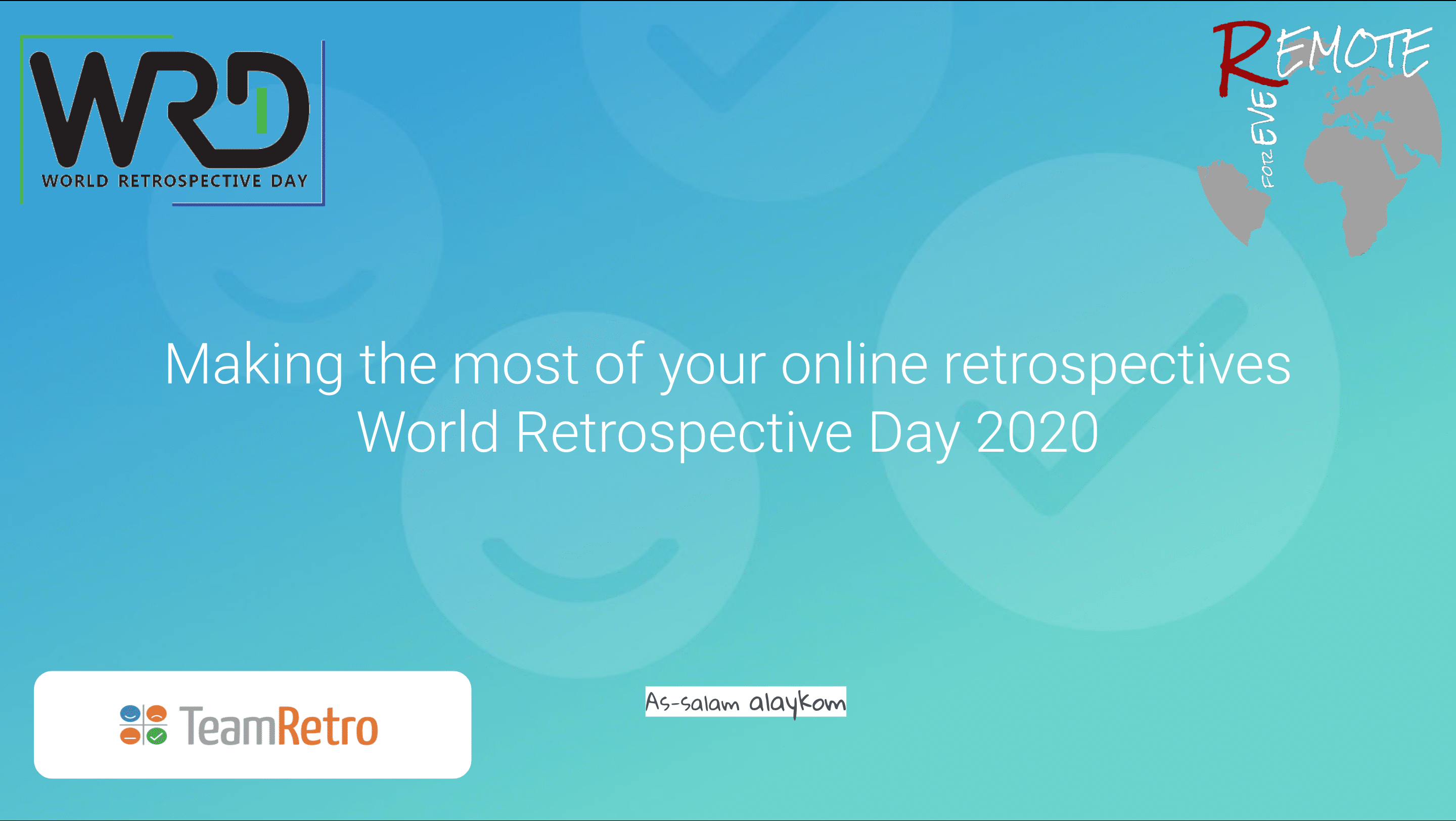Celebrating the Power of Remote Retrospectives
World Retrospective Day 2020 is a volunteer-based, globally coordinated effort to share stories and insights to improve Agile retrospectives. Two events held were the World Retrospective Day Lightning talks by Remote Forever and the Agile Club of Egypt monthly meetups. As teams become increasingly remote, running online team meetings that empower and drive continuous improvement is a key focus for Scrum masters. While there may be reduced travel costs and time, there are increased challenges in how remote meetings, especially retrospectives can be best run to ensure engagement and a sense of connection.
TeamRetro’s CEO and Co-Founder, Jeremy Lu, spoke at both events on the topic of “Making the most out of your remote retrospectives.” We share some of the key messages as well as learnings and insights from both the events here.
The pros and cons of running remote retrospective meetings
Going digital does mean adjustments to how team meetings run. But there are some neat benefits. Removing production blocks, reducing bias and allowing independent brainstorming and voting for actions can improve the quality of data as well as build psychological safety. Time that would have been spent writing up reports, manual collation and recording can now be spent on team relationships or giving more time to deep dive into discussions that matter.

On the other hand, reliance on an individual’s internet set up, security and the lack of accountability can negatively impact team trust. The increase of social dissonance as we lose the physical cues means that the role of the scrum master as the conductor of the social orchestra becomes evident. Building team culture from planned and explicit activities to setting ground rules for meeting hygiene are good practices to help to start to overcome these cons.
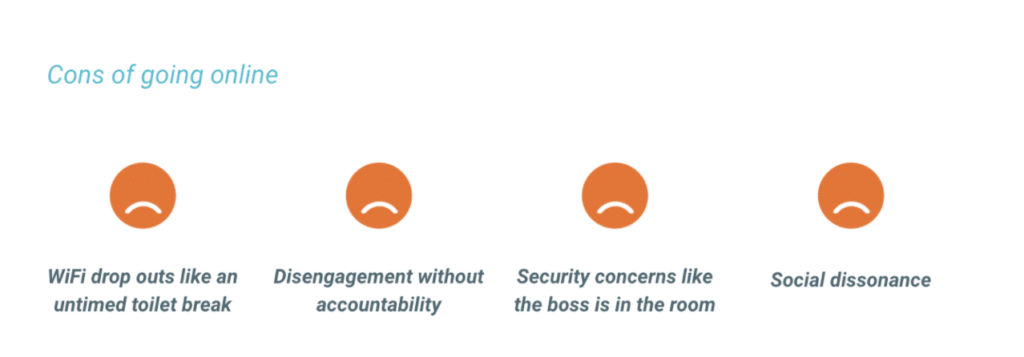
At the same time, irrespective of whether or not the team is distributed, co-located, remote or some blended hybrid, individuals in a team want:
- to be heard
- to be valued
- to be guided
- to feel safe
- to be resourced
- to be grown
So how can the humble retrospective play its role in helping address those team needs? Here are some ideas.
1. Develop a Team Social Contract
Setting the right focus and tone before you begin your retrospectives goes a long way to creating an engaging, safe and productive space for team members to speak up. The culture, group expectations, and agreed ground rules are more likely to stick and have an impact if they are created together and made visible.
We grabbed a couple of balloons and all wrote down things that we heard but did not feel like it was useful for a meeting. We then “popped” these balloons in an audible and significant way if we noticed these behaviors and words in a meeting. We then wrote down a list of guiding behaviors that our team wanted to use as part of our retrospectives as well as any team meetings and frame this when we kick start our remote retrospectives. In fact, it appears on our remote retro.
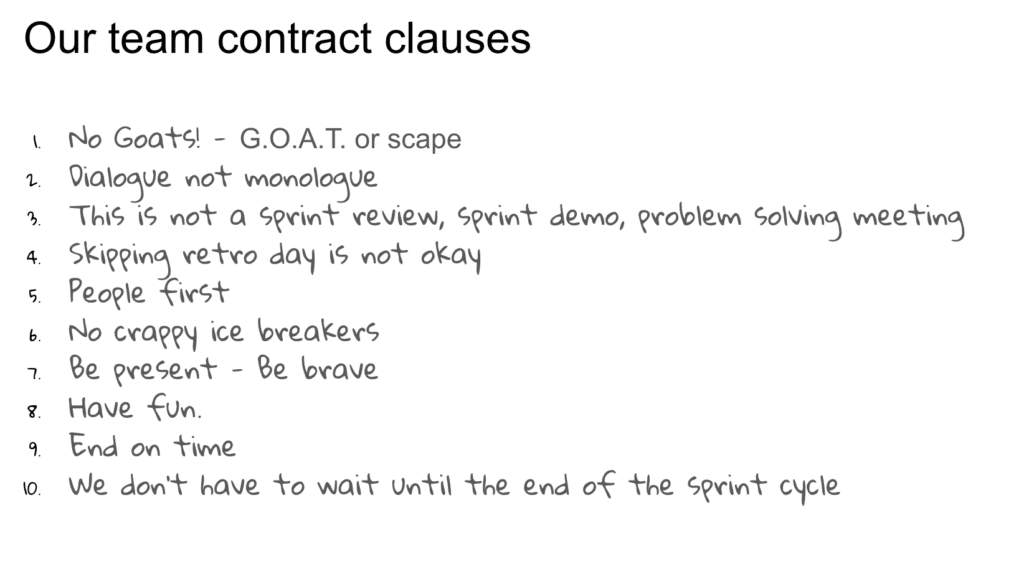
If you don’t want to go that far, then you can always rely on the Agile Prime Directive. However, addressing basic meeting etiquettes such as turning on cameras and audio, call signals to slow down, speed up, or make comments and other rituals can help make meetings more successful. If accountability and social dissonance are common in your meetings, then having processes like round-robin discussions, call-out facilitated conversations or liberating structure formats can help build that team engagement.
Takeaway: Whether you do it formally or more of an informal ritual, understanding and managing the social contract for your team builds trust, psychological safety, and clear online meeting retrospective etiquette.
2. Pick the right retrospective format to fit your purpose – fun? easy? focussed?
With so many different retrospectives formats and questions out there, Scrum Masters are spoilt for choice when it comes to variety. However, to get the most out of the retrospective, it was suggested that the choice of retrospective format requires intention, thought, and consideration so that it serves the purpose of the meeting.
This does mean the format will change from time to time which in its own right will lend itself to reducing the repetition fatigue. It will also mean that you are entering the meeting with intent and can focus the conversation.
Take this example below.
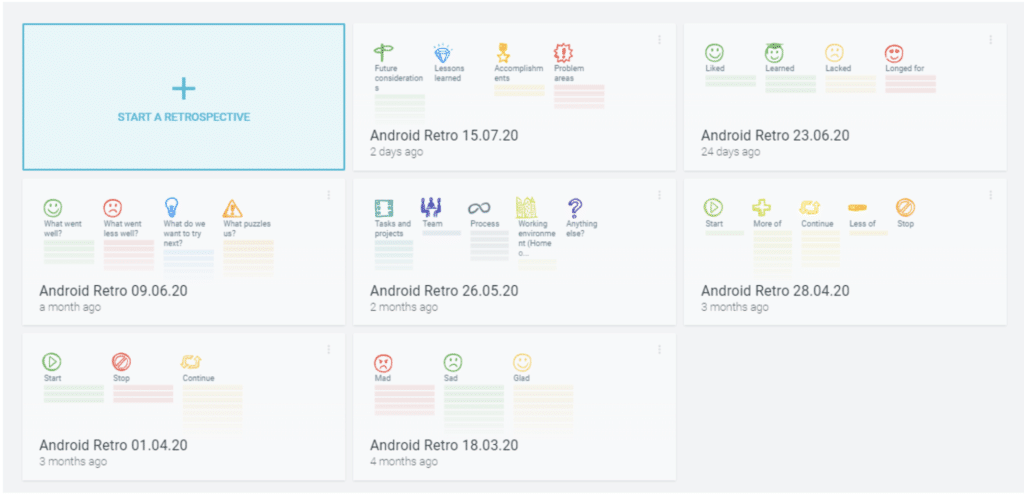
This team used the Mad Sad Glad approach to kick off their initial retrospective. This format has a more personal touch and requires people to consider their emotional responses to the last sprint. It helps to air out any potential issues and address any emotional barriers to help teams move past the storming stages of team formation.
The next few retrospectives focused more on action-based, focusing on a Stop, Start, Continue retrospective and the StarFish retrospective. These formats lend themselves to more action-based brainstorming and allow teams to consider time trade-offs between tasks.
As teams transitioned to working from home, they then focussed on changes in the process and how to work from home to talk through what they needed to do in a remote environment, followed by a standard agile retrospective at the end of the year.
Using the 4L retrospective next allowed them to reflect on the activities to date to share learnings as well as what they have liked and longed for. Finally, a FLAP (Future considerations, lessons learned, Accomplishments and Problem areas) was a futurespective process to help the team decide what they wanted to see going forward.
Of course, you can always create your own set, or choose topics that are seasonal or interest-based. There’s also the option to create retrospectives based on interest, festive seasons, famous TV shows, or a shared passion.
Takeaway: While a variety of retrospective formats is great to break meeting fatigue cycles, choosing one that is aligned with your team and product’s current state can improve the focus, intention and outcomes of your retrospective meetings.
3. Power up your retro flow.
Beyond splitting groups into smaller breakout rooms, there are some additional ways that you can level up on your team meetings.
At the start of each retro, run a short, sharp but friendly activity that allows people to check-in. Share a word, or facial expression that demonstrates how you felt about the last sprint, or even what was the last thing that made you smile is a great way to kick start the meeting. Remind them about the prime directive, social contract and remind them of why they are here to do.
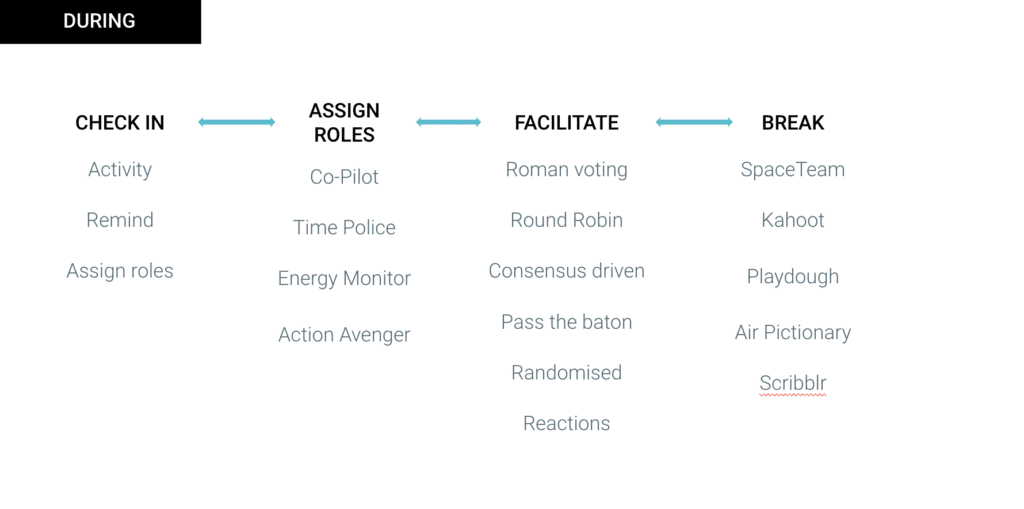
You can assign roles so that people can all contribute. The Co-pilot can help manage the tech and meet goals. The time police keep the meeting flowing and reminds people on time as they start to overrun. The energy monitor might run a quick check-in during the meeting or get a sense from people as to how the meeting is going and the Action Avenger can call out if there are actions that are not being discussed or captured.
Using a range of facilitation methods that allow people to contribute throughout the process keeps people engaged and lets you sense the vibe of the room. For E.g. using reactions on comments helps to capture sentiment, and the pass the baton pattern means that one participant can pick the next speaker.
Finally, if your meetings are longer than an hour then include a planned break. It just gives people time to breathe and re-calibrate. Take a break away from the screen or run an activity with the team that’s fun and can lift the energy. We call for lights out which means mics and cameras on (music on if they want) for a little focus time before coming back together.
Takeaway: Team engagement strategies through powering up the process flow at the very start and throughout the meeting can lift energy and accountability.
4. Experiment with different time-box recipes.
One way we can make sure meetings don’t run overtime is to use time-boxing. There’s a countdown timer in TeamRetro for each stage that can be used for example to give people a sense of how much time is left, as well as the I’m finished button to give you the heads up when people are ready to move on.
Assuming you are running an asynchronous 60-minute meeting, here’s our time box recipe that seems to work.
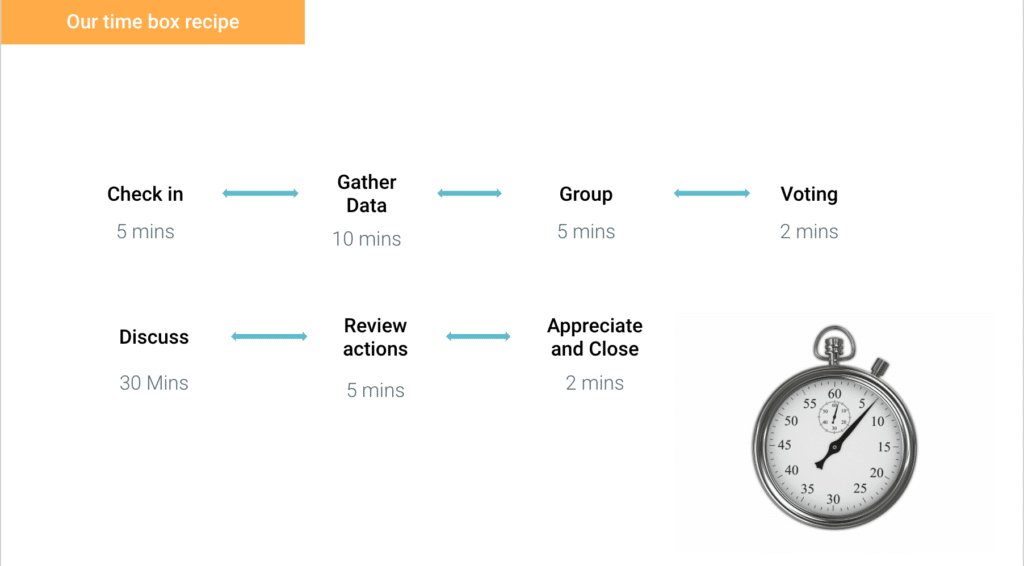
It may however be better to think of this in terms of a base recipe rather than a formal guide. Much like the pizza dough, the final pizza flavor is the combination and quantity of ingredients you decide to add on. If you think there’s a greater need for team bonding, then check-ins, appreciations, and check-outs might be important. Data can be gathered before the meeting asynchronously. Grouping of similar ideas can be done before the meeting and then ideas are voted on when read for discussion. Alternatively, if there is less need for rapport building, then this might be used more on building consensus for action items. For self-organizing teams, allow more time for them to group ideas that have come up. If there are lots of comments, then have them work in smaller groups under specific sections. While this might be good for a 60-minute meeting, you can simply change the ratios for a longer session.
Takeaway: The end of the meeting time is the main constraint for teams who like to finish on time with clear outcomes. Trying out new time-box recipes can help keep meetings on track and be a good marker for guiding conversations.
5. Make your retrospectives easy, fun and human!
Remember bring a pet day? Crazy shirt/hat day? Share a meal day? Who says we can’t do that online? Adding a little fun and team-building activity can be a good way to relieve stress, learn a little more about your team and get insights you won’t find in your standard retrospective. Here are a few things we heard teams have been doing while remote. (Some of our teams actually do this at the end as a reward for a good retrospective.)
- Use mood checkers.
- Play a game – agile or just for fun.
- Watch a movie together on Discord.
- Run a team-building activity, or example, if you are in a plane that crashed into a desert, what 10 items you want with you in order to survive.
- Story or picture telling: try asking everyone to tell a story about something, even something as small as a cup or a pair of shoes! Or to take a picture of something near them to share
- Guess the song: test your scrum masters singing capabilities by asking them to sing songs for the team to guess!
- Solve a random problem that someone else in the team has.
- Share a recipe that everyone tries at home and tastes.
Takeaway: Encourage compassion. It is not easy to move to a fully online team retro or remote working. We as humans are social beings after all. Having some fun, social activities can make it easier to build bonds and empathy that can make your retrospectives more meaningful and effective.
Excited to level up your remote retrospective?
We hope these insights provide a little inspiration. If you have others you’d like to share or would just like to swap notes, ask for advice or find out more, just get in touch! We’d love to hear from you. TeamRetro.
